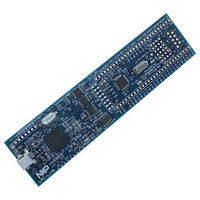OM13012,598 NXP Semiconductors, OM13012,598 Datasheet - Page 24

OM13012,598
Manufacturer Part Number
OM13012,598
Description
BOARD EVAL LPC11C2X
Manufacturer
NXP Semiconductors
Datasheet
1.LPC11C14FBD48301.pdf
(61 pages)
Specifications of OM13012,598
Featured Product
32-bit ARM Cortex-M0 Microcontrollers
Processor To Be Evaluated
LPC11C2x
Data Bus Width
32 bit
Core
ARM Cortex-M0
Maximum Operating Temperature
+ 85 C
Minimum Operating Temperature
- 40 C
Operating Supply Voltage
3.3 V
Lead Free Status / RoHS Status
Lead free / RoHS Compliant
Lead Free Status / RoHS Status
Lead free / RoHS Compliant, Lead free / RoHS Compliant
Other names
568-6645
OM13012
OM13012
NXP Semiconductors
LPC11CX2_CX4
Product data sheet
7.16.1.3 Watchdog oscillator
7.16.5.1 Sleep mode
7.16.2 System PLL
7.16.3 Clock output
7.16.4 Wake-up process
7.16.5 Power control
The watchdog oscillator can be used as a clock source that directly drives the CPU, the
watchdog timer, or the CLKOUT pin. The watchdog oscillator nominal frequency is
programmable between 7.8 kHz and 1.7 MHz. The frequency spread over processing and
temperature is 40 % (see
The PLL accepts an input clock frequency in the range of 10 MHz to 25 MHz. The input
frequency is multiplied up to a high frequency with a Current Controlled Oscillator (CCO).
The multiplier can be an integer value from 1 to 32. The CCO operates in the range of
156 MHz to 320 MHz, so there is an additional divider in the loop to keep the CCO within
its frequency range while the PLL is providing the desired output frequency. The output
divider may be set to divide by 2, 4, 8, or 16 to produce the output clock. The PLL output
frequency must be lower than 100 MHz. Since the minimum output divider value is 2, it is
insured that the PLL output has a 50 % duty cycle. The PLL is turned off and bypassed
following a chip reset and may be enabled by software. The program must configure and
activate the PLL, wait for the PLL to lock, and then connect to the PLL as a clock source.
The PLL settling time is 100 s.
The LPC11Cx2/Cx4 features a clock output function that routes the IRC oscillator, the
system oscillator, the watchdog oscillator, or the main clock to an output pin.
The LPC11Cx2/Cx4 begin operation at power-up and when awakened from Deep
power-down mode by using the 12 MHz IRC oscillator as the clock source. This allows
chip operation to resume quickly. If the system oscillator or the PLL is needed by the
application, software will need to enable these features and wait for them to stabilize
before they are used as a clock source.
The LPC11Cx2/Cx4 support a variety of power control features. There are three special
modes of processor power reduction: Sleep mode, Deep-sleep mode, and Deep
power-down mode. The CPU clock rate may also be controlled as needed by changing
clock sources, reconfiguring PLL values, and/or altering the CPU clock divider value. This
allows a trade-off of power versus processing speed based on application requirements.
In addition, a register is provided for shutting down the clocks to individual on-chip
peripherals, allowing fine tuning of power consumption by eliminating all dynamic power
use in any peripherals that are not required for the application. Selected peripherals have
their own clock divider which provides even better power control.
When Sleep mode is entered, the clock to the core is stopped. Resumption from the Sleep
mode does not need any special sequence but re-enabling the clock to the ARM core.
In Sleep mode, execution of instructions is suspended until either a reset or interrupt
occurs. Peripheral functions continue operation during Sleep mode and may generate
interrupts to cause the processor to resume execution. Sleep mode eliminates dynamic
power used by the processor itself, memory systems and related controllers, and internal
buses.
All information provided in this document is subject to legal disclaimers.
Rev. 2 — 3 December 2010
Table
15).
32-bit ARM Cortex-M0 microcontroller
LPC11Cx2/Cx4
© NXP B.V. 2010. All rights reserved.
24 of 61















